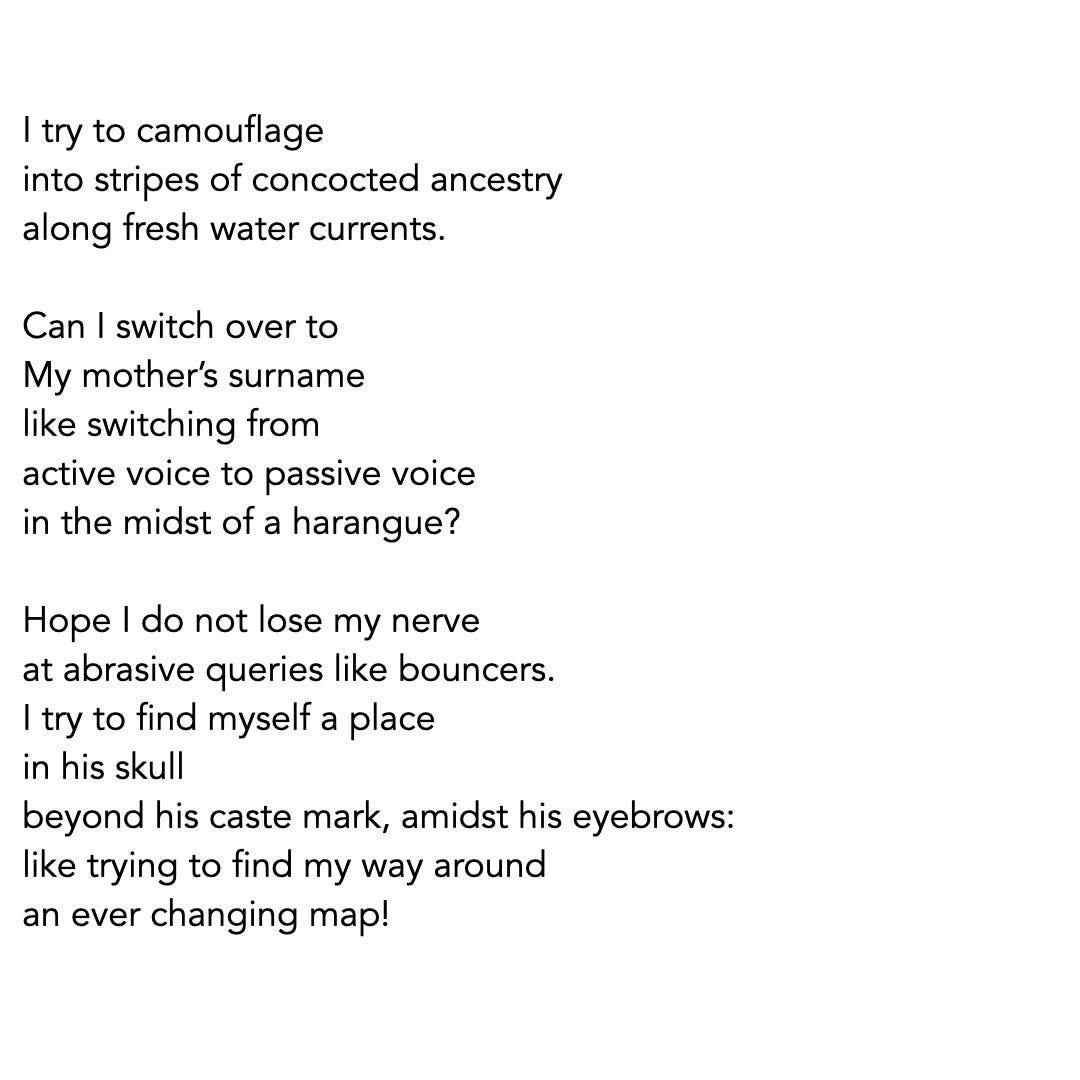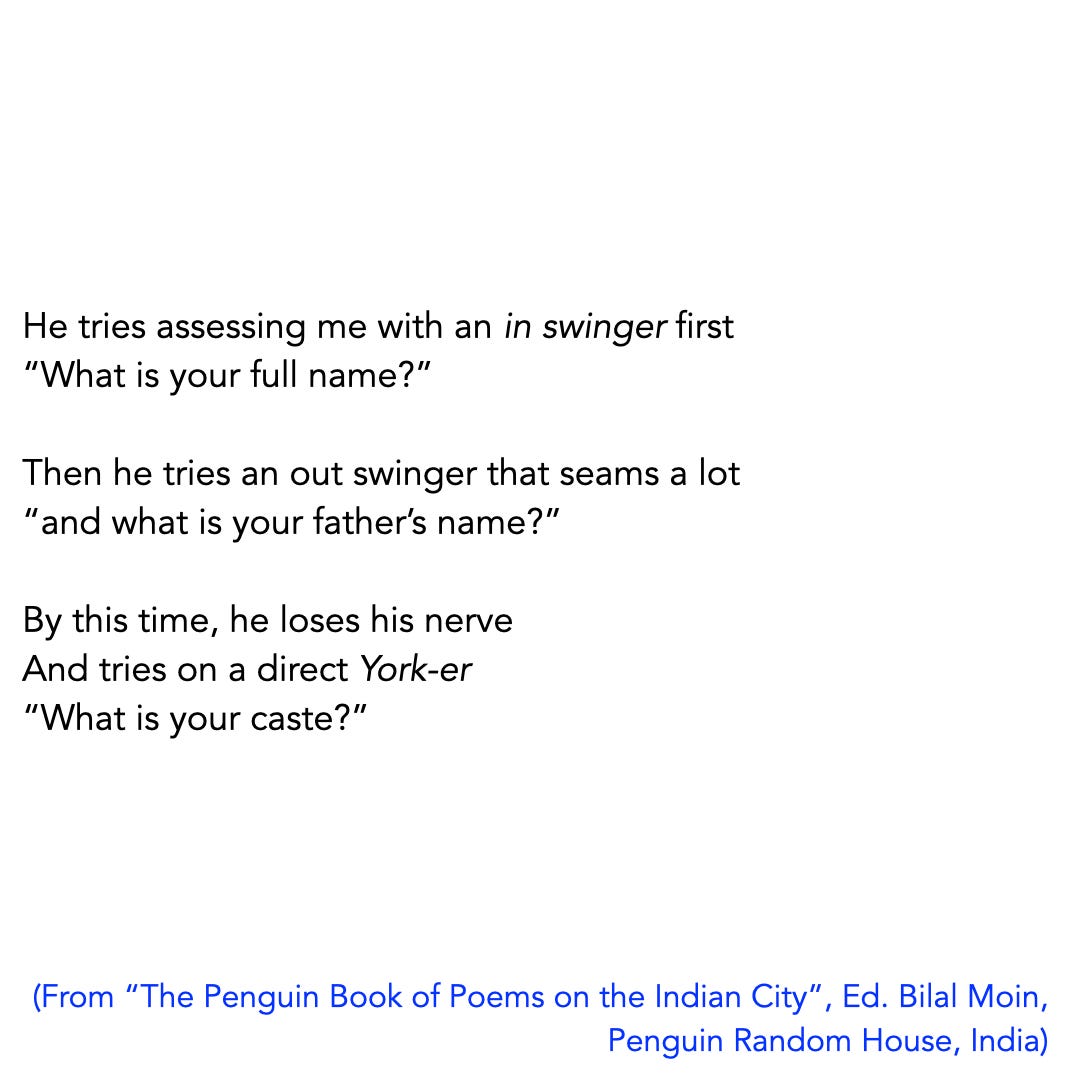“….. in-swinging yorker pitched outside off-stump”
This truncated set-piece of cricket commentary often enters my mind unbidden, at the least expected moment; perhaps, as I am walking down familiar neighbourhood roads, canopied by embracing trees and lined by vegetable thelas, or during a quiet pensive stroll in a Nana-Nani park that gently nudges the body moulting out of its stupor with staccato bursts of sighing green. If no one’s looking, my body would shift its weight to conjure up a mock-delivery - a devilish piece of fast bowling artistry that bamboozles the seasoned rival at the other end and eventually “shatters the furniture”. I don’t know why it’s this particular sporting tableaux that becomes the theatre for some gamified personal aspiration, some yearning or desire that the subconscious has deigned to push to the surface - but the theme of an “in-swinging yorker pitched outside off-stump” is recurrent enough to be memorable. Another line that I mouth frequently to myself - usually, while I’m doing some completely unrelated activity - comes from Badal Sircar’s Evam Indrajit. “Cricket a game of glorious uncertainty…”. I played Indrajit in a school production of this play. So that is where this come from.
I have found that the mind routinely plucks stray pieces of meaningless utterance - empty speech acts - in Aristotelian anamnesis from the perfectly formed subterranean nous of chidhood or pre-birth. The two snippets of sportspeak that I shared above are easily explained in the Indian context:
If, like me, you have grown up in this country in the 90s there is little chance that you have remained unaffected by the mad frenzy brought on by the sport. There is no slow “middle-overs” energy in this innings – either you are a part of the power plays or you are not. Like every privileged child who could afford to nourish the dream of sports stardom with relative ease in this country (through the cycle of viewership-consumption-cricket coaching-local leagues-Ranji), I wanted to be a cricketer when I was in middle school. But I wanted to be the “good-soldier”, the wall – Rahul Dravid, not Master Blaster, Sachin Tendulkar, in a time when the figure of the all-rounder was beginning to gain traction. A paragon of ethical play, calm composure and resilience, Dravid always “took one for the team”, and while he rarely bowled, he embraced the role of the wicketkeeper so that more talent could be accommodated in the playing eleven.
Since adolescence is about finding peer-circles and shared interests that will shape future beliefs about one’s identity, I tried to fashion my cricketing personality in that way. I was an average player …[and while I was obsessed with the flamboyance of spinners like Shane Warne and Muttiah Muralidharan]… Dravid was also a “safe” Savarna icon, an identity that periodically came to the fore through his controversial affiliations with the RSS.
(I cite from an article that I wrote in Outlook, recently)
The poem that I share today comes from poet-editor Bilal Moin’s fresh-off-the-tava-and-into-my-plate anthology: “The Penguin Book of Poems on the Indian City”. The collection which, of course does not claim to be exhaustive, covers a startling range of Indian poetry, sedimenting contemporary works with historical masterpieces from 37 different cities, and various languages in translation. While I am not always in favour of “canonisations”, I love the idea of curating series of works along the same theme. It is no mean feat, this kind of curation, and requires extensive and eclectic reading, with a sensitivity that seeks out moments of frisson in works about coalescing internal and external worlds. The collections surges towards a microcosmic representation of “Urban Indian Poetry”, while paying due homage to other anthologists who have attempted similar impossible projects.
In this effort, it must be noted, that it is an anthology that must be read by urban anthropologists and historians alike (apart from poets, artists, and aesthetes/rasiks of all hues and kinds). It is imperative that this kind of project opens up the analytic of “the city” to other allied and even dissonant domains, rather than closing it off into a niche, specialised area of study. The breadth and diversity of choice should ensure conversations that ricochet off tangential conceptual spaces reflected in the lifeworlds of the poets, as illustrated in their writings and metaphorical choices. Chandramohan Sathyanathan’s poem beautifully captures this sensibility.
The poem plucks from the primordial bank of cricket metaphors to render the fractures of caste that overwhelm the identity of the poet-persona, in a social context, during a conversation in a tightly packed train compartment. The gathering metaphors of cricket, rather than taking away from the intimate, suppressed tension of the exchange, repurpose the realism of the conversation to the conceptual space of an arena. Why not stick to the incident, a reader might ask? Why complicate a sensitive social institution with the reductiveness of a “popular” metaphor? My answer to this question proposes the belief that we do not see objects, things and situations as they are. The world is constructed in our minds indirectly, and not through literal perception. We naturally form likenesses in our habits of perceptive thought that parse observation and “sensing”. Analogy is intuitive method rather than craftiness, when we think of the ways in which we interpret and subsequently explain the world.
Graham Harman cites a striking passage to explain why the machinations of metaphor hold prime place in his contemporary philosophy of “objects”:
…In the following passage Pseudo-Dionysius is speaking about what many critics view as the weakest link in Christianity, the three-in-one Trinity of Father, Son and Holy Spirit:
“In a house the light from all the lamps is completely interpenetrating, yet each is clearly distinct. There is distinction in unity and unity in distinction. When there are many lamps in a house there is nevertheless a single undifferentiated light and from all of them comes the one undivided brightness.”
While I for one do not believe in the Trinity, I nonetheless find this passage marvellous. It makes brilliant use of analogy to convey some sense of how the apparent contradiction of ‘three persons in one Divine nature’ might be not only possible, but even lucidly conceived...
…There are numerous other examples in which indirect allusion, hint or innuendo are more powerful than direct access to the truth.
(Cited from the chapter “Aesthetics is the Root of All Philosophy” in Object-Oriented Ontology : A New Theory of Everything, Harman, G. A lucid text with layered allusions for those who are interested in this modality of exploration)
Chandramohan’s poem uses this powerful charge of metaphor to astounding effect - perhaps it even occurred to the poet during the experience (but our search is for the truth of “feeling” rather than experience/empiricism). Metaphor always works in dual and simultaneous spaces - the arena of cricket, and the arena of the local train; the lifeworld of the entitled Brahminical interrogator and the “caste-stained” object of questioning (in the eyes of the persona) who is seemingly “fair game” for such an incongruous exchange.
The metaphor of cricket limns the tonality of the poet’s voice with a playful, subversive defiance inherent in the judgement. The conversation turns into a kind of confrontation, and a gradual build up to the climactic “york-er”.
[The poem] is a startlingly precise and evocative reminder that dispels the notion of the absence of caste in the Indian city promising anonymity as the great equaliser. Caste remains untouched, only its form changes.
Note: Some parts of this commentary (including the quote above), and the poem are excerpted from my article in Outlook - Finding the Individual in the Crowd of Indian Cricket: From Stampedes to Caste Dynamics
Hope you, and your loved, are finding meaning and the space to create. Do write to poetly@pm.me if you have any questions, queries, or comments. I will write back as soon as I find the space, and the time.
If you like what you read, do consider ‘buying me a coffee’.






Thank you so peace